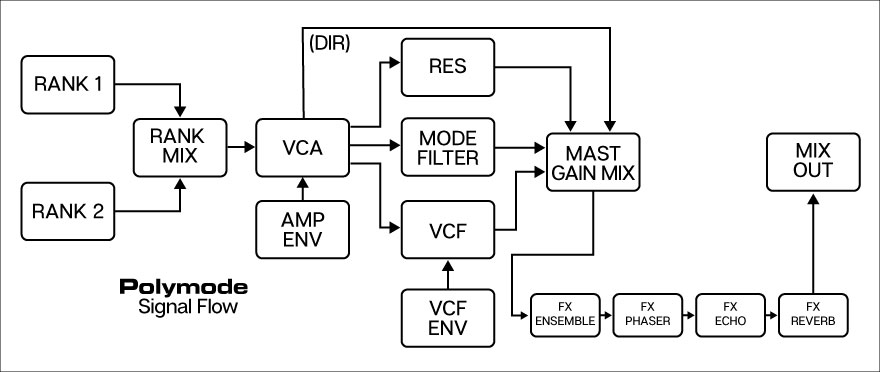Polymode Signal Flow
The original Polymoog works like a string synthesizer (or a transistor organ) on steroids. The pitches of two fixed high-frequency square-wave oscillators are "divided-down" (i.e. slowed down) to the frequency of each chromatic note of the very top octave. Another series of IC's halves the top-octave chromatic notes to create the remaining pitches for the entire length of the keyboard. This is how just about every 60s and 70s transistor organ and 70s string synth works (as well as a number of 70s polyphonic sort-of synthesizers such as the ARP Quadra, Korg Delta, etc.).
Though it sounds convoluted, top-octave divide synthesis (referred to as "TOC") was common because it's easy and cheap from an electronics standpoint, but it can only product square waves, which severely limits the tonal palette. To get around this, the original instrument contained a small circuit board called a "poly card" beneath each key with a custom IC chip (the "Polycom IC") that converted the square wave to a ramp wave and allowed the pulse width of the square wave to be adjusted and modulated. Because of its separate note generation for each key, TOC-based synths can't have a "mono mode," thus keyboard glide can't be implemented. Here's a block diagram of the signal path:
Following the oscillator "ranks" are the VCA/Amplitude Envelopes. This is unlike just about any other analog synthesizer - the VCA is almost always after the filter(s), not before. This is because the original featured individual VCA/Amplitude envelopes for every note on the aforementioned poly com cards beneath each key. It also means that every single note has its own independent envelope generator. The downside of this arrangement it that the VCF cannot be self-resonating because once it started "ringing," there would be nothing to stop its sound - in a more conventional analog synth, playing the keyboard would open and close the VCA, thereby stopping sound from the ringing filter.
Following the VCA/Amplitude Envelopes are three (!) separate filters, all fed in parallel. Mixing and matching these in the Master Gain mixer section, along with the unfiltered Direct signal, is one of the niftiest things to do with the original (and this is greatly enhanced by the Master Gain mixer's mod inputs). The filters are as follows:
• Resonators (see Resonators section for details)
• Mode Filters (see Mode Filters section for details)
• VCF (see VCF and Filter Envelope Sections for details)
The Resonators, Mode Filters, VCF are fed to the Master Gain mixer, then to the Ensemble, Phaser, Echo, and Reverb effects, then to the Master Out volume knob and main audio outputs.
________________
Lower/Upper/Octave Bal Controls- The original instrument included "lower" and "upper" duplicates of a number of its controls, allowing independent adjustment of various parameters at a fixed keyboard split point. Because only certain parameters had the dual controls, this resulted in a pretty half-baked attempt at keyboard split capabilities, and along with the already unusual control layout, tended to make it even more confusing. On top of this, it had three volume sliders that split the keyboard into three volume zones (with different fixed split points than the upper/lower controls!) for extra bonus confusion. We've eliminated all of this extra-control-splitty madness from Polymode - if you've never had your hands on the real thing, take our word, we did you a solid by ditching these confounding controls.
________________
In the following chapters, we'll detail each of Polymode's sections. Normally we would cover controls from left to right, but it doesn't exactly have a left-to-right signal flow, we'll start with the oscillator Rank controls, then follow the actual signal path.
